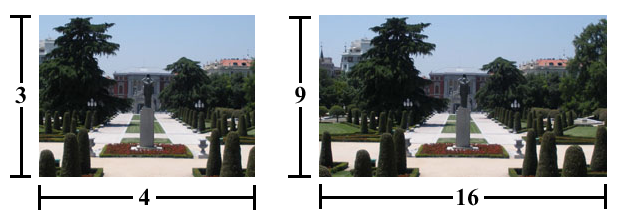HDTV
HDTV
stands for high definition television which is similar to regular old
television commonly known now as SDTV or standard definition television
with
two major differences.
The biggest
difference between HDTV and SDTV is the upgraded picture quality which
is
achieved from the higher resolution that HDTV provides.
The second major difference
is the size or
shape of the screen which is called the aspect ratio.
HDTVs have a screen aspect
ratio of 16 by 9 (widescreen)
instead of the 4 by 3 ratio of standard TVs as seen below.

Pictures showing the difference between 4:3 and 16:9 aspect ratios of standard and high definition televisions.
The main difference between HD and SD, and the reason many people are switching from their standard definition televisions to large high definition televisions is, the superb resolution and picture quality offered by HDTVs. To simplify things we will say that SDTVs have 480 vertical lines of pixels and about 640 horizontal lines of visible pixels (pixels are the colored dots that make up the picture displayed on the screen) for a combined total of about 307,200 visual pixels. Now this may sound like a lot of pixels but in reality the number is not as big as it sounds. Another point to add is that this number is the same whether you have a 15 inch TV or a 54 inch TV. (Note: the size of a TV is measured diagonally weather it is HD or SD.) So if you sit 3 feet away from a 15 inch TV it will look sharper than a 54 inch TV at the same distance since the pixels on the 54” TV are simply bigger on the bigger TV. The same is also true about HDTVs; however, there are many more pixels. While SDTVs display only 307,200 pixels the maximum number of pixels that an HDTV can display is 1080 lines of vertical pixels by 1920 lines of horizontal pixels for a total of 2,073,600 pixels. Below is a list of the different common resolutions that North American TVs display, but before we get to that one thing must be explained first. There are two different ways of displaying, or drawing the images on the screen. They are progressive and interlaced. The progressive format draws the full picture every scan cycle so in this example the image is fully drawn every 1/60th of a second or 60 times a second. The interlaced format draws half of the horizontal lines (the odd lines) once every cycle, in this case every 1/60th of a second, and then it draws the other half of the horizontal lines (the even lines) during the next 1/60th of a second; Therefore, drawing a complete picture every 1/30th (2/60=1/30) of a second or 30 times a second. One last thing worth noting is that there are different frame rates at which different TVs cycle or refresh. In the above example the refresh rate or frequency for both would be 60 Hertz, denoted as 60Hz, or 1080p/60 (depicting 1080 progressive at 60 Hertz per second).
SD and HD Resolutions Chart
|
Resolution |
Aspect Ratio |
Scanning Type |
Frame Rate (Hz) |
Approximate Pixel Resolution |
Type of Resolution |
|
|
Vertical |
Horizontal |
|||||
|
480 |
640 |
4:3 |
Interlaced |
30 |
307,200 |
SDTV |
|
480 |
640 |
4:3 |
Progressive |
24,30,60 |
307,200 |
EDTV |
|
480 |
720 |
4:3 or 16:9 |
Interlaced |
30 |
345,600 |
EDTV |
|
480 |
720 |
4:3 or 16:9 |
Progressive |
24,30,60 |
345,600 |
EDTV |
|
720 |
1280 |
16:9 |
Progressive |
24,30,60 |
921,600 |
HDTV |
|
1080 |
1920 |
16:9 |
Interlaced |
30 |
2,073,600 |
HDTV |
|
1080 |
1920 |
16:9 |
Progressive |
24,30,60 |
2,073,600 |
HDTV |
Common North American SD and HD Resolutions Chart. The grayed out EDTV (Enhanced Digital Television) formats are not generally recommended for purchase.
What is needed to watch HDTV?
Basically four things are needed to watch HDTV, the fist obviously being an HDTV. Here are the four in an easy to follow layout.
1. An HDTV
An HDTV or HD monitor (if used with correct source device and connections). For more info on HDTV sets and HD monitors please see our HDTV reviews and recommendations page located here.
2. An HD Source
This will most likely be one of the following:
A simple antenna to receive free Over-the-Air (OTA) or Free-to-Air (FTA) HD broadcasts. Check out our antennas page for more information on antennas and OTA/FTA broadcasts.
An HD broadcast service such as satellite or cable service. Keep in mind that the basic service usually will not contain any HD channels. For more information on HD service and comparisons between the major television service providers check out our television providers comparison chart.
An input source such as a Blu-ray player or gaming station such as the Sony PlayStation 3 (PS3), Microsoft Xbox 360 or Nintendo Wii or even a computer.
All of these devices will need to be connected using the proper connections. For more information on connections and wiring guides click here.
3. An HD Channel
Once you are receiving HD broadcasts from a service provider you will need to tune in to a channel that is broadcasted in HD since almost every provider (DirecTv for example) currently offers both HD and SD content on different channels (e.g. ESPN and ESPNHD), so be sure you are tuned to the HD version of the channel (if it is available).
If you are using an antenna to receive OTA/FTA broadcasts your TV will usually tell you what the resolution is. You may need to press the info or display button if this information is not automatically displayed. Remember that 720p, 1080i, and 1080p are all HD resolutions.
If you are using a Blu-ray player or similar device you will need content (a movie or game - depending on the device) that is in HD.
4. An HD Show, Movie or Program
Just because a channel is broadcasted in HD does not necessarily mean that all of the shows on the channel will be in HD, so be sure to find a show that is broadcasted in HD. There are many shows available in HD depending on your provider and service you selected. You may need to use your on screen guide in order to find out which shows are broadcasted in HD. For more information on the different providers and the HD content they offer, click here.
If you are using a Blu-ray player or similar device, you will need content (a movie or game - depending on the device) that is in HD, as stated above.
HD Audio
Along with the high definition picture, high definition audio is also now available and included in most high def broadcasts received via antenna, cable, or satellite. Dolby Digital, also known as AC-3 or DD 5.1, allows for up to five discrete (separate) channels of sound as well one low-frequency effects (LFE) channel. These five speakers (six including the subwoofer – the speaker which produces the low frequencies such as the rumbling heard from an explosion), along with an audio receiver capable of decoding Dolby Digital, will envelop you in sound from movies and TV shows making you feel like the action is taking place all around you instead of just in front of you, as is often the case when using a two channel speaker system such as the TV’s built-in speakers. The surround sound from a full home theater stereo system truly brings HDTV to life without the need for a trip to the local movie theater cinema. For much more on HD audio and home theater systems and receivers check out our home theater audio page.
Other Points of Interest
1. DTV and HDTV – They are not the same thing!
DTV is short for digital television and is very similar to the regular older analog television with the exception that DTV receivers receive digital broadcast ATSC signals, rather than the old analog NTSC broadcasts, both transmitted via UHF and VHF radio waves. DTV should not be confused with HDTV which is also receives digital signals. All televisions produced for sale in the United States have been digital since March 1, 2007. For more information on DTV check out our DTV page.
2. Letterbox and Pillarbox
Letterboxing is used in order to preserve the original format of a film or program which is wider ratio than the screen which you are viewing it on. For example many shows viewed on SDTV, 4:3 format were originally shot for, and intended to be viewed on, a 16:9 aspect ratio HDTV. Therefore, in order to correctly display the full image without panning and scanning (panning from side to side to ensure that the essential parts of each shot fit the screen) letterboxing is often used.
Pillarboxing is usually used when video displayed on a 16:9 HDTV was shot using standard definition technology not intended to take advantage of HDTV (such as old video) but then shown on an HD broadcast.
Windowboxing is a combination of both letterboxing and pillarboxing. It is most often seen on a channel that broadcasts in HD but currently is only showing an SD program.



3. DVDs and Upconverting
DVD (Digital Versatile Disc) will also look better on HDTVs even though the DVD technology itself is an SDTV technology there are a few tricks it uses in order to improve picture quality and achieve an image quality much higher than the typical 480i standard definition resolution. This is achieved by a process called anamorphic widescreen and was done in order to correctly display DVDs in their original theatrical widescreen format, no matter whether you are watching it on a widescreen HDTV or an SDTV. This process starts by recording the movie to the DVD as horizontally squeezed images using complex mathematical formulas. When the DVD player plays back the images to display them on the TV it checks to see whether it is configured to output in 16:9 or 4:3 format. If it is set to 4:3 format, it electronically draws the black letterbox at the top and bottom of the screen and then goes through another mathematical formula to stretch the picture back out by effectively turning every four lines of vertical resolution into three lines. When the output is set to 16:9 the video signal is sent out to the TV which stretches the image out horizontally until the proper aspect ratio is met (the letterbox bars not displayed since they were never actually recorded to the disk). In order for this to work, the DVD must be an anamorphic disc; however, almost all DVDs produced nowadays are. Also, to get the best picture, be sure to use the highest quality type of, HDMI connections if possible.
Upconverting is the process of taking the 480i format of a DVD and converting it into a higher resolution to then be output to an HDTV. While this sounds like a great idea, when starting with a 480i resolution and then enlarging it (referred to as scaling the image) to a higher resolution, the image you start with is the best quality image you can get. However, there have been many advances in the way DVD images are displayed, so this saying isn’t always the case. The best advice I can give is to check it out for yourself. Watch your favorite DVD at home on your current DVD player and TV, and then take that DVD to your favorite electronics store and try it out there. Be sure to test it on a TV of similar quality and size as your own. Another thing to watch for is the connection. Be sure your player is connected using the best quality connection it has (HDMI, if available) because chances are that the store will have it connected via HDMI so that no picture quality is lost between the image transfered from the DVD player to the TV. I would recommend trying out a couple of different upconverting DVD players in order to be sure that a cheap one won’t perform as well as one of the more expensive ones. Also, this may be the best time to upgrade to a Blu-ray player since most of them contain DVD upconverters. Keep in mind that the Sony PlayStation 3 (PS3) plays all most all of the formats in use today, including Blu-ray (BD), and does a good job at it.
4. Degraded image quality on some or all channels?
This can be caused by many different things. Here are a few to check (see the troubleshooting page for more information):
Are the channel and the program on it HD? If not try turning to a channel with an HD program on.
Be sure that the best connection between the TV and the source (satellite/cable box/DVR/DVD player) is used. HDMI should be chosen if possible; if not, use component if available, next S-video and lastly composite.
Check the TV’s settings if the picture looks stretched or squeezed or just not quite the right aspect. Look for “Picture Mode” or “Zoom”. You will probably need to play around with these settings to set it the way you like best. One thing you will have to decide is if you want a pillar-box look for standard definition programs for a sharper and correct aspect ratio or a stretched/zoomed-in look with an incorrect aspect ratio but a picture that fills the screen.
Keep in mind that the bigger the TV, the easier it is to see flaws in the picture, which is even more pronounced the closer you are to the TV.